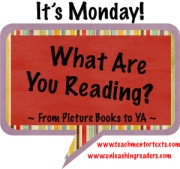

Myra here.
It’s Monday, What are You Reading is a meme hosted by Jen from Teach Mentor Texts and Kellee and Ricki from Unleashing Readers (new host of Monday reading: Kathryn T at Book Date). Since two of our friends, Linda from Teacher Dance and Tara from A Teaching Life have been joining this meme for quite awhile now, we thought of joining this warm and inviting community.

Today is an extra special Monday reading, as we are officially launching our new reading theme for July-August. Since I am still in Europe and have been here since the last week of May, we have decided on a “Literatura Europa” reading fest until end of August 2017. Essentially we are looking for the following books:
- Books written by authors/illustrators/artists from Europe – including the following countries (see this website for source of country list):

- Books about or are set in Europe (the whole gamut: poetry, comic books, children’s books, YA/MG literature, adult novels, memoirs/non-fiction, novels-in-verse).
- International titles published in their original European languages or have been translated into English.
- Books written or illustrated by European authors/artists in diaspora.
To launch our reading theme, I thought of sharing four European twists to a well-loved but potentially-sinister fairy tale: Little Red Riding Hood.
 The True Story Of Little Red Riding Hood
The True Story Of Little Red Riding Hood
Written by: Agnese Baruzzi Illustrated by: Sandro Natalini
Published by: The Templar Company, 2007 ISBN: 0763644277 (ISBN13: 9780763644277). Bought a copy of the book. Book photos taken by me.
I first came across this picturebook at our library at the NIE (National Institute of Education). When I saw that it was in the reserved section or can only be borrowed within 24 hours, I made sure that I purchased a copy that I can use in my higher-degree class.

Think of this as a prequel to the actual Little Red Riding Hood fairy tale, providing some context as to why the wolf did what he did – in a pop-up, interactive format. In the tradition of Scieszka and Smith’s The True Story of The Three Little Pigs, this provides background information about Little Red that readers may not know about.

You see, Wolf had every intention of turning vegetarian – he was actually a model forest animal: bringing flowers to grandmother, driving the school bus, helping Little Red’s Mother with the cooking – so much so, that he was even featured in the news!

However, all this attention has made Little Red incredibly jealous. She thought that she will be getting the credit for Wolf’s transformation, but then Little Red’s popularity continues to dip while Wolf’s continues to rise. I liked the colour pinwheel that showed how Little Red became increasingly agitated and quite literally green with envy:
And so, Little Red did something really wicked to prove her point – and the rest, as you know, is the faery tale you’ve always loved. Again, while seemingly-simple and straightforward, it raises important questions to adult readers as to whether one’s nature can truly be transformed, can there truly be a good wolf? Beyond the existential queries, the interactive nature of this pop-up books would most likely be a hit among a lot of young readers.
The author, Agnese Baruzzi, is said to be the daughter of a typographer and a librarian and grew up surrounded by books. She lives in a countryside close to Bologna, Italy. Baruzzi and Natalini supposedly met while studying in Urbino, Italy, and has since then collaborated on several book projects together.
Little Red Hood
Written and Illustrated by: Marjolaine Leray
Published by: Phoenix Yard Books, 2010. Originally published in French by Actes Sud Junior under the title un petit chaperon rouge, English Translation by: Sarah Ardizzone, 2010. ISBN: 1907912002 (ISBN13: 9781907912009). Bought a copy of the book. Book photos taken by me.
I am floored by the deceptively-simple and stark nature of this picturebook that is mischievous, sparse, and subversive. This story is clearly between the Wolf and Little Red – there are no sick grandmothers or heroic woodcutters here: just Wolf preying on Little Red from the very first page of the book:

The vulnerability of Little Red is heightened by Wolf’s much-larger size, his scary teeth, and his sinister articulations of intending to have this red-clad little girl for dinner:

Just when he thought things would go smoothly according to his evil plan, he has already donned his white bib, opened his huge mouth for the “joooosey red meat,” the young girl boldly faced the Wolf and started fearlessly describing what she sees: the Wolf’s big ear, his big teeth, how hairy he is, and so forth:

And just when the Wolf was about to take a bite, Little Red said unequivocally and with conviction, just one word: NO.

How the story ends, I shall leave for you to discover. Definitely one of my favourite retellings of the story. Leray was born in 1984 in a small village in the Loire-Atlantique and moved to Paris and studied visual communication at the Duperré School of Art. If you want to know more about Marjolaine Leray, click here to be taken to her website.
 Little Red Riding Hood
Little Red Riding Hood
Written by: Perrault Photographs by: Sarah Moon
Published by: Creative Education Inc., 1983. ISBN: 1568461437 (ISBN13: 9781568461434). Bought a copy of the book. Book photos taken by me.
This must be one of the more disturbing versions of Little Red that I have encountered (and I have read quite a number of them by now). Rather than illustrations, Sarah Moon (born in France), shared stark black-and-white photographs that amplified the disquieting vibe of the story:

Set in an urban jungle – cityscape, the text-narrative is unadorned and placed in a separate page from the photographs, and followed Perrault’s version pretty closely:

If you are looking for redemption, however, this may be the wrong book to pick up, as there is none to be had. While there is one bright image here as you can see below:

it only serves to juxtapose that innocence with the darkness that is lying in wait in Grandmother’s house, with the Wolf waiting for this open-faced young girl who took her sweet time running after butterflies and making nosegays of little flowers that she found along the path.

I believe a number of academic papers have now been written to analyze this version of Little Red, along with a few others. Suffice it to say, that this is a collector’s fairy tale title that you definitely need to add to your bookshelf.
The Girl In Red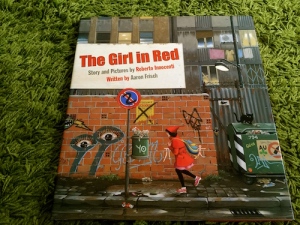
Story and Pictures by: Roberto Innocenti Written by: Aaron Frisch
Published by: Creative Editions, 2012
Bought a copy of the book. Book photos taken by me.
I learned about this book when I attended the International Research Society for Children’s Literature Conference in Birmingham last year. One of the conference presenters talked about this picturebook and responses of both educators and students to the story. And I knew, right then and there, that I should get my own copy of this book.
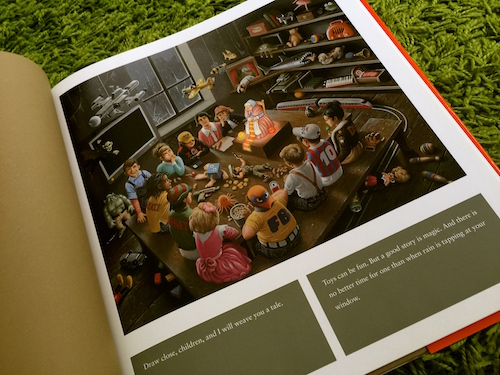
The story opens with a tiny toy-like grandmother weaving a story to a group of children indicating varying shades of interest/disinterest. This opening reminded me a little bit of the Filipino Lola Basyang who tells fairy tales to a group of wide-eyed young children sitting around her as she does her knitting.
Know this, though, children: Stories are like the skies. They can change, bring surprises, catch you without a coat.
Look up all you want, but you never really know what’s coming.
The reader could sense from the first few pages alone that this would be a disturbing version of the familiar Red Riding Hood. For one, the woods have been transformed into an urban jungle of sorts. Yes, Nana is still sick – and a modern-looking, harried Mother with curlers in her hair asked Sophia to bring a pack of biscuits, honey, and oranges to Nana who “lives on the other side of the forest.”
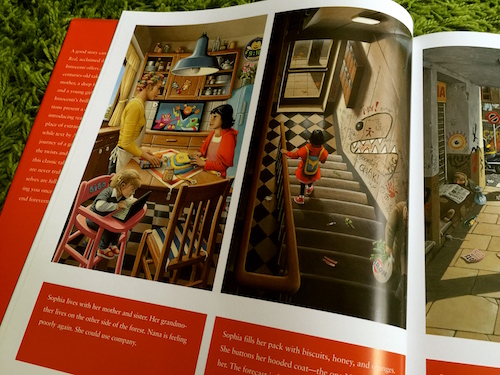
In this story, the ‘forest’ is one that most city folks are familiar with. It is in this landscape that the reader is able to catch glimpses of womanity – seeming portrayals of the objectification of females in billboards and ads, and the ever-present wolf that is embedded like so many visual clues within the pages.
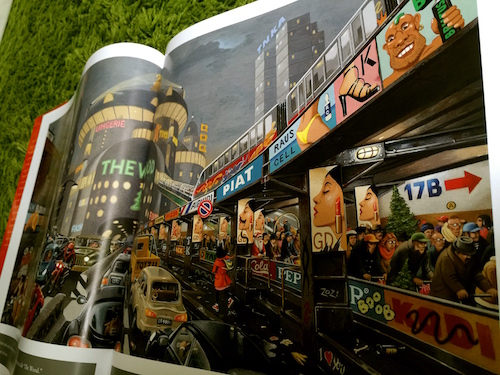
There is visual overload here as the reader drowns in such a media-saturated, hyper-busy landscape that feeds off the air of consumerism – from lingerie to toys, everything one could ever want or need can be found in a place called “The Wood” – found in the central part of this page.
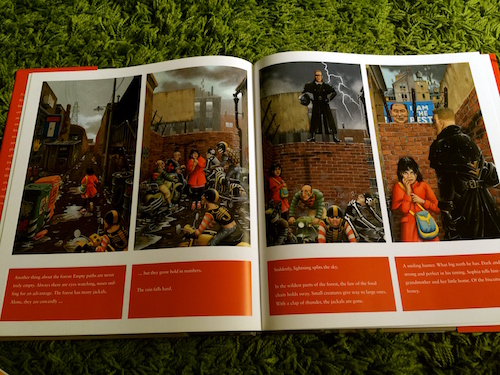
The big bad wolf also has a very different look as evidenced in the image above. The hunter who drove off the jackals and who gave Sophia a ride in his motorcycle, dropping her off along the way as he receives a phone call and claimed “he can go no further.” Of course, he found his way in Nana’s trailer – and what happened there is so horrific, it demanded the presence of the Polizot and the FDI in the end, with the hunter fleeing after Sophia found her way inside Nana’s trailer – way before the police even came into the scene.

What is different, though, about this story – despite this ending – is Grandma’s reminder to the children who were crying over Sophias’s plight about their power to change the direction of a narrative:
Remember the thing about stories? Stories are magic. Who says they can have only one ending?
During the conference presentation, the speaker mentioned how some teachers reacted so strongly against this picturebook that they noted how they will not use this with their own students in the classroom. Interestingly, students’ responses are quite positive, as the story empowers them to do a restorying of their own possibly unfortunate circumstance, reminding them that they are the change they need to turn their story around.



I love twists on fairy tales. These all sound interesting. The True Story of Little Red Riding Hood makes me think of The True Story of the There Little Pigs. The Girl in Red sounds very different. It looks very dark.
LikeLike
If I could find them, I think I might share with my middle school students, Myra. They are very different, and take a theme that would make a good discussion, i.e. could we “take” a similar message from a “softer” story of Little Red Riding Hood? Why does the author choose to change the story? Thanks, will see what I can find!
LikeLike
I love European picture books and struggle to find out about them, so I’m excited about this new theme and looking forward to adding many books to my TBR list.
LikeLike
I’m really excited about your new theme!
I did a summer course with Jack Zipes one year where we looked at disrupting fairy tales in the process of developing critical literacy. I’ve been a fan of Red Riding Hood stories ever since. I have a collection of Perrault’s tales, but alas, my library doesn’t have this one. I’ve just ordered my own copy of The True Story Of Little Red Riding Hood!
LikeLike
It’s fascinating to compare different interpretations of classic tales – so many of the original fairy tales were dark and menacing in nature, acting as cautionary tales without happy endings, so it’s amusing to see people be shocked by modern interpretations which in fact seem closer in spirit and tone to the originals!
LikeLike